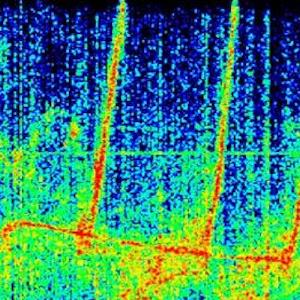The article was originally published at http://www.bordermovement.com/exploring-instability/ - A part of short features representing electronic musicians exploring synthesis and sound-art in India.
"Electronic sound devices are far less restricted and adverse to absolute pitch and timbre "
"Electronic sound devices are far less restricted and adverse to absolute pitch and timbre "
A revolution is on its way, changing the way music and sound can be imagined in the near future" : a prophetic comment made by Pierre Schaeaffer (French sound theorist and music concrete visionary) way back in 1972. " Why does electronic and orchestral music have to be restricted and enslaved to a repeating constant : that of pitch and tempo ? Can you imagine music with tempi ?(constantly changing tempo) " A question posed by Karlheinz Stockhausen (German composer and electronic music pioneer ) in a letter titled " Advice to Clever Children " - Wire Magazine 1995. Stockhausen, Schaeffer, Steve Reich, John Cage and a host of other modernists (dealing in the future of sound and music in the 60s and 70s) were challenging the principle of stable musical instruments and further demystifying the universe of frequency manipulation. This exploration into uncharted and unheard of sounds would lead to modular synthesis and the magic of controlled chance ...

Decades later, as music synthesis would become an art in itself, reshaping again and again from a state of 'medusa' cables running for miles into a universe of modular, subtractive, additive, fm, modeling, virtual and wavetable synthesizers. The future visions had surely manifested itself a thousand times in virtual and real ways, without doubt. Thousands of musicians got sucked into the endless highway of the sound and unsound. Across the world, synthesis of one sort or another accounts for 90% of what we hear in terms of sound and music. Yet within this 90% enormity of homogenized and industrial electronic sounds, beats, chords, styles, trends and techniques, is a tiny presence, a fringe group of artists who continue to push aside the boundaries of absolute pitch and tempo. Kicking the technological curve to produce what we can't imagine yet. Always trying to break the pattern, committed to states of glitch and chance, exploring the 'un'quantized and chaotic effects of sound creation. Effecting the human psych with a medium which is amorphous and androgynous.
" I am exploring instability. Searching the 'other' side of the sound spectrum..." Where most composers usually don't dwell or even reach " comments Lionel Dentan when asked what his vision of electronic music and sound is all about. " Over time I have acquired an acute likeness for music outside the standard methods of creation and consumption. With modular synthesizers the journey of sound has turned unlimited and the aural possibilities infinite ". 16 years now living in India, and having traversed a decade of Indian classical music on the Sitar ( under tutelage of Late Ustad Sattar Bhai - Bangladesh ), Lionel has produced many projects exploring sounds of electronic and acoustic nature, from various countries and cultures. Growing up listening to punk and jazz, Lionel did not foresee his vast musical journey from Switzerland to India. In 2008, Jet Lag (a post-modern sufi pop project) produced by Lionel and David Scufari featuring an international cast of musicians was released by Phat Phish Records, Mumbai.

Background 2001 - 2012 : With his wife Namrata Pamnani, an emerging Kathak dancer and choreographer, Lionel has co-created dance based performances, applying electronic sound upon movement art. Lionel and Ish (Edgecut / Sound Reason) have produced a host of recordings experimenting with concepts of tone, noise and glitch. Several of these compositions have been featured in the Sound Reason Compilation (Volume 1 & 2) produced by Ish in association with Sarai, Goethe Institut and Khoj : This collaboration has further expanded gradually with an international faculty of sound artists / groups such as Rastar Noton and Eisentanz from Germany and Andy Guhl from Switzerland. His extensive participation in the CeC (Carninal of E Creativity) has lead to discovering circuit bent gadgets and his initial foray into D.I.Y synth building ethics. Captain Dubroshniev, another avatar of Lionel featuring the multi instrumentalist Gena Lavrentiev from Moscow is about ambient, melodic and deep frequency manipulated passages. " We tried to imagine the inside of a submarine, stuck in the Aral Sea. The captain exiled, alone in his cabin with some synthesizers .. for life.
His early exploits into synthesis were ad-hoc. Extended improvisations using digital and virtual sources merging with acoustic instruments and effects. Taking live jabs at synthesizers and drum machines along-with his cohort Audio Pervert resulted in " some far out, near mad sound parties at my house " Lionel recounts earlier recording and jam sessions circa 2006 till 08, and the involved 'audio bonhomie' with synthesizers and like minded friends. "We would create bizarre and evolving sound atmospheres. Patching in as many instruments one could… I was not really interested in making 'safe' dance music just because I had gotten a Roland TR606 or the SH101 or even have to quantize my beats to any constant tempo. I discovered CV and the analog synthesizer signal blew my head off. The improvisation jams would go on for 6 to 8 hours. Leaving us empty and quiet in the head, the next day ". Over time, Lionel acquired an array of monophonic synthesizers and boutique sound devices as his main weapons of sound and noise. As contrasting to his understanding of synthesis, his exploration into middle-eastern music structures and instruments ( Saaz, Rabaab and Ud) is a vital link to his dual east-west mindset. On lazy days he would play a bit of jazz and blues on the guitar as well. Yet, Lionel remains rather reticent about his musical journey and the accolades within.

Q. Tell us a bit about the analog sound and modular synthesizers ?

Decades later, as music synthesis would become an art in itself, reshaping again and again from a state of 'medusa' cables running for miles into a universe of modular, subtractive, additive, fm, modeling, virtual and wavetable synthesizers. The future visions had surely manifested itself a thousand times in virtual and real ways, without doubt. Thousands of musicians got sucked into the endless highway of the sound and unsound. Across the world, synthesis of one sort or another accounts for 90% of what we hear in terms of sound and music. Yet within this 90% enormity of homogenized and industrial electronic sounds, beats, chords, styles, trends and techniques, is a tiny presence, a fringe group of artists who continue to push aside the boundaries of absolute pitch and tempo. Kicking the technological curve to produce what we can't imagine yet. Always trying to break the pattern, committed to states of glitch and chance, exploring the 'un'quantized and chaotic effects of sound creation. Effecting the human psych with a medium which is amorphous and androgynous.
" I am exploring instability. Searching the 'other' side of the sound spectrum..." Where most composers usually don't dwell or even reach " comments Lionel Dentan when asked what his vision of electronic music and sound is all about. " Over time I have acquired an acute likeness for music outside the standard methods of creation and consumption. With modular synthesizers the journey of sound has turned unlimited and the aural possibilities infinite ". 16 years now living in India, and having traversed a decade of Indian classical music on the Sitar ( under tutelage of Late Ustad Sattar Bhai - Bangladesh ), Lionel has produced many projects exploring sounds of electronic and acoustic nature, from various countries and cultures. Growing up listening to punk and jazz, Lionel did not foresee his vast musical journey from Switzerland to India. In 2008, Jet Lag (a post-modern sufi pop project) produced by Lionel and David Scufari featuring an international cast of musicians was released by Phat Phish Records, Mumbai.

Background 2001 - 2012 : With his wife Namrata Pamnani, an emerging Kathak dancer and choreographer, Lionel has co-created dance based performances, applying electronic sound upon movement art. Lionel and Ish (Edgecut / Sound Reason) have produced a host of recordings experimenting with concepts of tone, noise and glitch. Several of these compositions have been featured in the Sound Reason Compilation (Volume 1 & 2) produced by Ish in association with Sarai, Goethe Institut and Khoj : This collaboration has further expanded gradually with an international faculty of sound artists / groups such as Rastar Noton and Eisentanz from Germany and Andy Guhl from Switzerland. His extensive participation in the CeC (Carninal of E Creativity) has lead to discovering circuit bent gadgets and his initial foray into D.I.Y synth building ethics. Captain Dubroshniev, another avatar of Lionel featuring the multi instrumentalist Gena Lavrentiev from Moscow is about ambient, melodic and deep frequency manipulated passages. " We tried to imagine the inside of a submarine, stuck in the Aral Sea. The captain exiled, alone in his cabin with some synthesizers .. for life.
His early exploits into synthesis were ad-hoc. Extended improvisations using digital and virtual sources merging with acoustic instruments and effects. Taking live jabs at synthesizers and drum machines along-with his cohort Audio Pervert resulted in " some far out, near mad sound parties at my house " Lionel recounts earlier recording and jam sessions circa 2006 till 08, and the involved 'audio bonhomie' with synthesizers and like minded friends. "We would create bizarre and evolving sound atmospheres. Patching in as many instruments one could… I was not really interested in making 'safe' dance music just because I had gotten a Roland TR606 or the SH101 or even have to quantize my beats to any constant tempo. I discovered CV and the analog synthesizer signal blew my head off. The improvisation jams would go on for 6 to 8 hours. Leaving us empty and quiet in the head, the next day ". Over time, Lionel acquired an array of monophonic synthesizers and boutique sound devices as his main weapons of sound and noise. As contrasting to his understanding of synthesis, his exploration into middle-eastern music structures and instruments ( Saaz, Rabaab and Ud) is a vital link to his dual east-west mindset. On lazy days he would play a bit of jazz and blues on the guitar as well. Yet, Lionel remains rather reticent about his musical journey and the accolades within.

Q. Tell us a bit about the analog sound and modular synthesizers ?
A. Most people might not care one way or another. Yet analog devices and synthesizers
sound way better, warmer or even crazier than virtual or number crunching models of
synthesis. I have spend years in virtual or digital synthesis and that is all fine to a point.
Yet analog synthesizers and their sound sculpting capabilities remain esoteric and special due to the intricacies of each manufacturer and the hardware which gives certain synths a signature sound. The reason 'acid heads' go wow when they hear a typical 303 bass squelch. As for the modular systems, it is the final frontier of synthesis. An open system where individual units such as oscillators, filters, ADSR shapers, matrix sequencers, effects, sampling delays etc. can be routed and patched in any logical progression. The signal flow in modular systems is infinite in terms of modulation and dynamic control. An universe in there [pointing to his modular rack]. You decide everything in there … Within minutes a given atmosphere can evolve into something unimaginable. There are many good virtual modular synths such as the Nord Virtual and the N.I. Reaktor, for one to learn the basics building blocks for all kinds of synthesis. Though its easy to understand why the 'working musician' or even the emerging 'EDM jock' don't care about modular or analog synthesis, as it takes a while to get musically 'useful' results from such open synthesis. There are no presets to dial in and get instant gratification. Guess that is why it is mostly reserved in nerdy, academic or audiophile circles. Though, off late I do see a clear trend in many younger electronic musicians who want to experiment and use analog synthesizers.
Q. Tell us about your approach to playing live ?
A. It has changed a lot over the years. I made many changes in my set-up bit by bit. I prefer to use my modular systems ( Make Noise or Intellijel ) as my principle instrument for extended and experimental performances. I do like using drum machines and monophonic synths (such as the Korg Volcas and Roland SH101) for acid-house and techno inspired sets. My favorite piece of 'ambience and dub' making device is the Moog delay which is a part of my arsenal on most live performances. On more ambient and obscure sound settings I prefer using some of the boutique sound toys such as the Buddha Machine, VTOL and the Leploop. I really dig the circuit bent Gameboy along-with the modified Casio SK1 for glitchy, noisy brain-feeder type of music. The semi modular systems such as the Doepfer Dark Energy and the Epoch are reserved for more harsher and deep bass frequencies, sometimes made even worse with the use old guitar pedals ( the infamous RAT distortion ).
Discog 2007 - 2012
sound way better, warmer or even crazier than virtual or number crunching models of
synthesis. I have spend years in virtual or digital synthesis and that is all fine to a point.
Yet analog synthesizers and their sound sculpting capabilities remain esoteric and special due to the intricacies of each manufacturer and the hardware which gives certain synths a signature sound. The reason 'acid heads' go wow when they hear a typical 303 bass squelch. As for the modular systems, it is the final frontier of synthesis. An open system where individual units such as oscillators, filters, ADSR shapers, matrix sequencers, effects, sampling delays etc. can be routed and patched in any logical progression. The signal flow in modular systems is infinite in terms of modulation and dynamic control. An universe in there [pointing to his modular rack]. You decide everything in there … Within minutes a given atmosphere can evolve into something unimaginable. There are many good virtual modular synths such as the Nord Virtual and the N.I. Reaktor, for one to learn the basics building blocks for all kinds of synthesis. Though its easy to understand why the 'working musician' or even the emerging 'EDM jock' don't care about modular or analog synthesis, as it takes a while to get musically 'useful' results from such open synthesis. There are no presets to dial in and get instant gratification. Guess that is why it is mostly reserved in nerdy, academic or audiophile circles. Though, off late I do see a clear trend in many younger electronic musicians who want to experiment and use analog synthesizers.
Q. Tell us about your approach to playing live ?
A. It has changed a lot over the years. I made many changes in my set-up bit by bit. I prefer to use my modular systems ( Make Noise or Intellijel ) as my principle instrument for extended and experimental performances. I do like using drum machines and monophonic synths (such as the Korg Volcas and Roland SH101) for acid-house and techno inspired sets. My favorite piece of 'ambience and dub' making device is the Moog delay which is a part of my arsenal on most live performances. On more ambient and obscure sound settings I prefer using some of the boutique sound toys such as the Buddha Machine, VTOL and the Leploop. I really dig the circuit bent Gameboy along-with the modified Casio SK1 for glitchy, noisy brain-feeder type of music. The semi modular systems such as the Doepfer Dark Energy and the Epoch are reserved for more harsher and deep bass frequencies, sometimes made even worse with the use old guitar pedals ( the infamous RAT distortion ).
Discog 2007 - 2012
Electronic
http://vimeo.com/user7741082
http://lioneldentan.bandcamp.com/track/sulphabrik
Acoustic
http://lioneldentan.bandcamp.com/
https://soundcloud.com/lionelbaba/sets/jet-lag-2008/
http://vimeo.com/user7741082
http://lioneldentan.bandcamp.com/track/sulphabrik
Acoustic
http://lioneldentan.bandcamp.com/
https://soundcloud.com/lionelbaba/sets/jet-lag-2008/
FURTHER INTRODUCTIONS INTO SOUND ART AND EARLY SYNTHESIS
Pierre Schaeaffer
http://en.wikipedia.org/wiki/Pierre_Schaeffer
Karlheinz Stockhausen
http://en.wikipedia.org/wiki/Karlheinz_Stockhausen
Advice to Clever Children!
http://www.stockhausen.org/ksadvice.html
Pierre Schaeaffer
http://en.wikipedia.org/wiki/Pierre_Schaeffer
Karlheinz Stockhausen
http://en.wikipedia.org/wiki/Karlheinz_Stockhausen
Advice to Clever Children!
http://www.stockhausen.org/ksadvice.html



























0 -